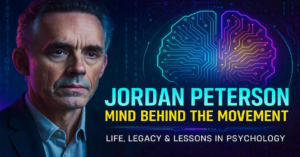Jordan Peterson Decoded: The Intellectual Blueprint for Modern Chaos
The Eternal Dance: Jordan Peterson Vision of Order, Chaos, and the Human Condition

The Fundamental Reality: Two Primordial Forces
At the heart of Jordan Peterson philosophical system lies a binary as ancient as mythology itself: Order and Chaos—the twin pillars of human existence. Order represents the known, the structured, and the predictable: your morning routine, societal laws, and the comfort of tradition. Its shadow side manifests as stagnation, tyranny, and the suffocation of creativity. Conversely, Chaos embodies the unknown, the formless potential of existence: the unexpected job loss, the creative breakthrough, and the shattering of worldview after tragedy. Yet within its depths lie both creative rebirth and annihilating terror.
Peterson crystallises this duality through evolutionary biology and mythological analysis. Our ancestors, he argues, encoded this understanding in creation myths worldwide—particularly in the Genesis narrative where God’s Word (Logos) imposes order on primordial chaos. This isn’t mere superstition but a profound mapping of psychic reality: consciousness itself emerges when we impose conceptual order on chaotic sensory input.
Jordan Peterson : The Dual Nature of Order and Chaos
| Order | Chaos |
|---|---|
| Explored territory | Unexplored territory |
| Predictability | Uncertainty |
| Structure & tradition | Creativity & possibility |
| Tyranny/stagnation (shadow) | Annihilation/terror (shadow) |
The Psychology of Meaning: Walking the Tightrope

Human flourishing occurs not in order or chaos alone but in the dynamic tension between them. Peterson illustrates this through clinical experience: patients trapped in excessive order suffer debilitating rigidity, while those drowning in chaos experience paralyzing overwhelm. The optimal path resembles a “tightrope walk”—maintaining enough structure for stability while embracing sufficient uncertainty for growth.
This balance manifests practically through Peterson’s now-famous rules:
- “Stand up straight with your shoulders back” confronts chaos through embodied confidence, adopting the posture of those who navigate uncertainty successfully.
- “Tell the truth—or at least don’t lie” prevents the accumulation of psychological chaos. Every falsehood creates a destabilizing disconnect between internal reality and external presentation.
- “Pursue what is meaningful, not what is expedient” anchors us in values when chaotic temptations arise.
The neuropsychological foundation reveals why this works: our brains process novel stimuli (chaos) through the amygdala-driven threat response, while familiar patterns (order) activate reward pathways. Meaning emerges when we consciously mediate between these systems—a concept Peterson expands in Beyond Order: 12 More Rules for Life, written during his wife’s cancer battle and his own benzodiazepine dependence crisis. His personal descent into chaos—Russian rehab clinics, induced comas—became the crucible for rules like “Be grateful in spite of your suffering”.
Jordan Peterson : Ideologies, Sovereignty, and Collapsing Societies
Peterson’s analysis extends beyond the individual to civilization’s architecture. Societies thrive when balancing structured institutions (order) with individual sovereignty (chaos-introducing innovation). He identifies two catastrophic imbalances:
- Too Much Order: The 20th century’s totalitarian regimes demonstrated order’s pathological extreme—ideologies like Stalinism demanded rigid conformity, exterminating dissenters as “chaos agents.” Peterson argues this impulse lives on in “forced diversity” initiatives that prioritize group identity over individual merit, creating what he terms “ideological possession”.
- Too Much Chaos: Societies abandoning shared values and narratives descend into nihilistic fragmentation. Peterson points to rising mental health epidemics and declining social trust as symptoms of chaotic cultural decay.
The antidote? Classical liberalism—not as mere politics but as a psychological framework honoring the “sovereign individual” who revitalises decaying structures. Peterson traces this to Judeo-Christian foundations: the individual as divinely imbued with the responsibility to “subdue chaos” through truthful speech and ethical action. When institutions suppress these individuals—as when the Ontario College of Psychologists threatened Peterson’s license for climate change skepticism—they commit what he calls a “spiritual crime” against society’s regenerative capacity.
The Alchemy of Transformation: Jordan Peterson
Peterson’s most revolutionary contribution lies in framing personal crisis as an alchemical vessel. Chaos isn’t merely to be feared; it’s the essential ingredient for rebirth. Clinical examples abound:
- A woman trapped in an abusive marriage (pathological order) must confront the chaos of leaving to achieve autonomy.
- A depressed man avoiding career change (fearing chaos) must tolerate uncertainty to discover vocation.
The mechanism for this transformation is truthful articulation—”making order from chaos through specific speech.” When patients precisely name their suffering (“My marriage feels like imprisonment”), vague dread crystallises into addressable reality. This mirrors Genesis’ Logos—divine speech imposing order on void.
Jordan Peterson : The Alchemical Process of Chaos Integration
| Stage | Psychological Process | Practical Application |
|---|---|---|
| Chaos | Crisis/disintegration | Job loss, illness, betrayal |
| Confrontation | Truthful articulation of reality | Journaling, therapy, honest conversation |
| Ordering | Implementing new structure | New routines, boundaries, goals |
| Integration | Renewed meaning/perspective | Wisdom, resilience, purpose |
Peterson’s own life demonstrates this: his 2016 clash over compelled speech legislation (Chaos) birthed a global movement (New Order). His near-death experiences during illness forged Beyond Order‘s emphasis on gratitude amid suffering.
Jordan Peterson : From Climate Debates to Culture Wars
Peterson’s framework illuminates contemporary conflicts with startling clarity:
- Climate Change Controversy: Peterson dismisses “net zero alarmism” not as science denial but as ideological chaos masquerading as order. He argues climate models ignore human ingenuity (chaos’s creative force) while enabling governmental overreach (toxic order). The psychological driver? A “psychogenic epidemic” of apocalyptic anxiety seeking control through authoritarianism.
- Identity Politics: For Peterson, reducing individuals to group identities (race, gender) commits the “great ideological lie of diversity”. True diversity emerges organically when individuals develop competence—not through quotas enforcing superficial variety while suppressing viewpoint diversity.
- The University Crisis: Academia’s shift from truth-seeking to “safetyism” represents order’s pathological excess. When universities prioritize ideological conformity over challenging ideas, they abandon their chaos-engaging purpose: “You need to be shocked out of your dogmatic slumber,” Peterson insists.
The Path Forward: Responsibility as Antidote
Ultimately, Peterson’s philosophy culminates in a deceptively simple prescription: Assume maximum responsibility. His clinical data reveals astonishing correlations—individuals embracing burdens (aging parents, challenging careers) often report increased life meaning despite objective hardship. Why? Responsibility forces engagement with chaos’s productive edge.
Practical implementation occurs through:
- Self-Authoring Tools: Peterson’s online programs guide users in “writing their future”—structuring chaos through goal-setting and past-trauma analysis.
- Microcosmic Ordering: “Make one room in your home beautiful” (Beyond Order’s Rule 8) starts with tangible domains before tackling psychic chaos.
- Truthful Speech: Rejecting ideological possession requires articulating precise objections—not just “I disagree,” but “This violates individual sovereignty because…“
Conclusion: The Eternal Rebalancing Act
Jordan Peterson’s exploration of Order and Chaos resonates because it mirrors our lived reality. We are creatures forever caught between security and adventure, tradition and innovation, certainty and mystery. His genius lies in reframing this tension not as pathology but as the arena of meaning-making.
The stories that endure across cultures—heroes descending into darkness (Chaos) to retrieve wisdom (New Order)—are not mere myths. They are roadmaps for existence. Peterson’s clinical work with trauma survivors reveals this pattern empirically: those who “voluntarily confront the dragon” of their suffering emerge not unscathed but enlarged.
In a fragmented world seduced by simplistic ideologies, Peterson’s call for balanced responsibility remains bracingly countercultural. His legacy, still unfolding, may ultimately reside in restoring psychology’s original mandate: not just alleviating suffering, but guiding souls in the eternal dance between darkness and light—where meaning is forged in the crucible of courageous existence. As he concludes in Maps of Meaning:
“The most profound truths are written in the oldest stories. Our task isn’t to escape them, but to decipher their code and live them anew“.
Leave a Reply
Want to join the discussion?Feel free to contribute!